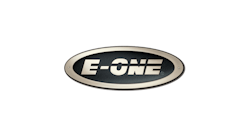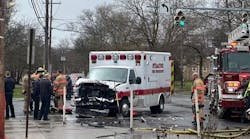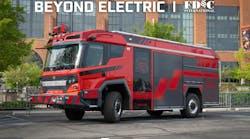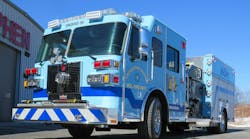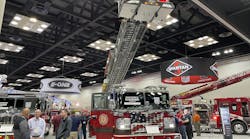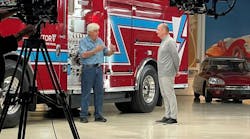Firehouse Magazine recently asked fire apparatus manufacturers to join a roundtable to discuss the all-important issue of vehicle safety. The U.S. Fire Administration (USFA) reports that vehicle crashes represent the second-leading cause, or about 25%, of firefighter line-of-duty deaths. The USFA has joined with other fire organizations, including the International Association of Fire Chiefs (IAFC), International Association of Fire Fighters (IAFF) and the National Volunteer Fire Council (NVFC), in efforts to reduce this toll and ensure firefighter safety.
In light of this important initiative, and our focus on firefighter safety, Firehouse® invited apparatus manufacturers’ chief engineers or their representatives to discuss what they are doing now or planning to do to improve safety for firefighters. We asked each company to discuss safety-related technologies and describe any new safety, driving or ergonomic initiatives. We also asked what each believes can be done to reduce the rollover potential of apparatus.
We thank the companies that participated in this roundtable and invite all apparatus manufacturers to participate in upcoming exchanges of important information.
AMERICAN LaFRANCE
Doug Kelley
Pumper ProductManager
American LaFrance
Doug Kelley, the pumper product manager for American LaFrance, graduated from the U.S. Naval Academy in 1991 with a bachelor of science degree in mechanical engineering. He served in the Navy until 1996. During that time, he graduated from the Navy’s Damage Control Assistant School with training in firefighting and rescue. He also was a 2½-year member of the damage control training team on the cruiser USS Mississippi out of Norfolk, VA. From 1996 to 2003, Kelley was chief engineer for S&S Fire Apparatus. He oversaw the development of many new products, including the industry’s first commercial non-metallic elliptical tanker. Kelley has worked for American LaFrance since 2003.
Firehouse: It takes years for new technology to be tested and added to fire apparatus. Please describe any new safety, driving or ergonomic features that we can expect to see in new fire apparatus.
Kelley: American LaFrance has a number of projects in process or under consideration. Rather than discussing items specific to my company, let me highlight some higher level trends.
Within the fire industry, we are seeing a strong movement from active safety to passive safety. Active safety items are items that require operator action to be fully effective. An example of an active safety device is a pump discharge relief valve. It’s there on the pump panel, but it requires the operator to properly pre-set the necessary pressure, and many models have the ability for the operator to override it. Active safety items generally require a more experienced operator with a strong knowledge of how the system works. Passive safety items, on the other hand, do not require any particular operator action to be effective and cannot be easily overridden. Examples include air bags or anti-lock brakes. This transition from active to passive has been underway for many years in other industries, but has only just begun in fire trucks.
Furthermore, on the cab/chassis side, if you want to see what’s coming down the road, you only have to look at the trucking industry. If you see it coming for the over-the-road trucking fleet, it will only be a matter of time before it shows up on a fire truck.
One of the concepts I’m most excited about is electronic braking / steering integration. This will go above and beyond the anti-lock braking systems currently standard on all new apparatus. This system will monitor throttle, braking, steering wheel position, and acceleration in order to adjust individual wheel brakes and engine speed to minimize the opportunity to take the vehicle into an unsafe condition. Airbags and restraint systems are useful, but preventing the accident in the first place is infinitely preferable.
In addition, there will be movement to air disc brakes for both the front and rear axles. These brakes don’t fade and allow the vehicle to stop in some cases up to 125% quicker than current drum brakes. These are currently available on some axle models and will be available on more in the near future. I would not be surprised if at some point these brakes were industry standard.
Also, radar and infrared technology will start to become widespread. Radar technology will be used for collision avoidance. It can be used on the apparatus while it’s in motion by monitoring the blind spots. The technology is currently available for small radar transceivers to be mounted on the back of the rig which warn when the unit is backing into an obstacle. The same technology could also provide warning of approaching cars if the unit is operating on the side of the road.
Infrared will be more vocational. Remote-controlled infrared cameras will allow the officer to size-up the scene on approach and even scan a building exterior for fire spread. They may even be used to search for accident victims when operating in rural areas at night. This is just the logical next step from the thermal imaging cameras that have exploded on the industry. Both technologies will be controlled and monitored using integrated in-cab screens.
Because fire suppression is becoming a smaller percentage of the emergency services work load, the pump will take up less and less real estate of the typical fire truck (without sacrificing capability). In addition, pump panel controls will continue to be streamlined and simplified. This will range from graphical groupings of valves and gauges to single-point digital controls that monitor and control all vehicle functions from pump output pressure to valve controls to deck gun operation to generator operation to area lighting. As an example, this system could be used to safely pressurize a pre-connected handline and bring the pump to a pre-set discharge pressure at the touch of a single button.
Finally, ergonomic equipment storage systems will become prevalent on most new vehicles. These will be designed to store a lot of equipment in tight spaces while still allowing it to be readily accessed when needed. It will also position the equipment where it can be most easily used, such as putting heavy items as low as possible. European manufacturers have been experts at this for many years, and it’s begun to spread to U.S. markets. This will include completely enclosed hose storage designed to secure the hose while still allowing it to be quickly deployed upon arrival at the scene. Such systems will be designed to facilitate easy loading and unloading without having to hang off the side of the truck or climb to unsafe locations.
Some of these advances will be driven by manufacturers. Some of them will be driven by market demand from individual fire departments. All will have an impact on cost and service. One thing that’s certain, though, is that the typical truck of 15 years in the future will look very different from the typical truck of today.
Firehouse: What can be done to reduce the rollover potential of apparatus, such as wider tires or suspensions, when drivers steer apparatus near the edge of road surfaces?
Kelley: American LaFrance has introduced two major items that help improve the stability of the vehicle. The first is a new proprietary AAC axle which increases the wheel track by three inches. While no one should expect that this is a cure-all, it’s a simple matter of geometry and physics; a wider track takes more lateral acceleration to roll. These new axles also include air disc brakes which improve stopping distance. In addition, I mentioned previously the electronic systems that monitor brakes, throttle, steering, and acceleration. American LaFrance has recently made available a simple version of this type of system from Meritor-Wabco called Roll Stability Control (RSC). This system reduces the chance of an understeer situation by manipulating brakes and throttle when it senses a potentially dangerous situation. Future systems will build upon this foundation.
One other consideration to reduce the rollover potential is to pay very careful attention to the load distribution and truck configuration. As everyone knows, there is movement in some circles toward trucks being able to have it all – deep storage compartments, big water tanks and lots of hose. This all goes to push the truck upward. Again, this is not a magic bullet, but the lower the center-of-gravity, the lower the risk of rollover, so cutting back may be in order. This should be considered when the truck is being specified and loaded.
Despite these improvements, however, running off the right side of the road is still one of the most dangerous scenarios for the vehicle. When I was in the Navy, we used to have a saying, “Don’t test the interlocks.†That meant that we weren’t to rely exclusively on the built-in safety devices to keep us out of trouble. In this scenario, there’s no substitute for experienced and timely operator action, but hopefully these systems will provide some level of backup.
DARLEY
Michael C. Ruthy
Vice President – Engineering
W.S. Darley & Co.
Michael C. Ruthy, vice president – engineering for W.S. Darley, graduated from Lafayette College in 1985 with a bachelor of science degree in mechanical engineering. He was employed at Hale Inc. (now Hale Products) from 1985 to 1989, and has been with Darley since 1989.
Firehouse: It takes years for new technology to be tested and added to fire apparatus. Please describe any new safety, driving or ergonomic features that we can expect to see in new fire apparatus.
Ruthy: The latest electronic integration is quite innovative. New vehicles will use multiplexing and will have touch screens or similar displays to control all aspects of the fire truck’s operation, including pressure regulation, foam mixing, traffic guidance and tank water level regulation. All engine and pump parameters will be displayed and recorded. These values will be recorded during road operation as well, providing the ground equivalent of a flight data recorder. After an accident, investigators will have better information about truck operations during that accident, information that may lead to a better understanding of the accident’s causes, which in turn will lead to better and safer designs in the future.
Firehouse: What can be done to reduce the rollover potential of apparatus, such as wider tires or suspensions, when drivers steer apparatus near the edge of road surfaces?
Ruthy: Wider tires can help, providing the driver an earlier warning of the imminent danger and staying in contact with the road surface a little longer, allowing a better chance of recovering control of a vehicle that is edging off the road surface. As trucks become more sophisticated, equipped with more sensors and greater computing power, other innovative solutions also arise. Vehicles that can change their suspension’s handling characteristics in milliseconds can react to minimize dangerous conditions in real time as they occur. These types of improvements will reduce the danger of rollovers, but the need for good, established procedures, properly followed by trained and qualified drivers, will never be eliminated.
E-ONE
Brian Cardinal
Vice President of Product Development/Engineering
E-ONE
Brian Cardinal is vice president of product development/engineering at E-ONE, responsible for developing new products and holding a lead function with product engineering. He earned a bachelor of science degree in mechanical engineering from the University of Massachusetts at Lowell and a master of science degree in industrial engineering from University of Central Florida as a Martin Marietta Fellow. Cardinal has been with E-ONE since 1999. Prior to E-ONE, he spent 18 years with Lockheed Martin Electronics and Missiles Systems involved in the design, development and manufacture of defense systems used by U.S. and foreign militaries.
Firehouse: It takes years for new technology to be tested and added to fire apparatus. Please describe any new safety, driving or ergonomic features that we can expect to see in new fire apparatus.
Cardinal: In general, the technology trends tend to start with automotive, get scaled up to the over-the-road trucks and then convert to fire apparatus. With this said, I would expect continued emphasis on better braking, electronic enhancements such as traction control, antiskid braking systems (ABS), roll stability control (RSC) and steering systems to become more responsive through rack and pinion and power assist. For operator protection during an accident, the use of seatbelts anchored to structural members of the cab are still the best protection supplemented by automatic seatbelt tensioning systems, structurally sound cabs driven by better safety standards and airbag systems more like automotive (impact actuated).
Firehouse: What can be done to reduce the rollover potential of apparatus, such as wider tires or suspensions, when drivers steer apparatus near the edge of road surfaces?
Cardinal: Rollovers can occur due to several factors, the first being the design of the vehicle. The center of gravity and the weight distribution, both front to back and side to side, will cause a vehicle to have a higher propensity to roll if it is put in a situation resulting in high lateral Gs. In addition, older vehicles not up to recent National Fire Protection Association (NFPA) standards (pre-1991) have fewer safety features. Paying strict attention to the tire manufacturer’s ratings and properly sizing suspension components will help in the overall stability.
Proper vehicle maintenance includes proper tire inflation, tire wear, brake components and systems, suspension performance and proper chassis lubrication. If the vehicle is designed and maintained properly, it will still be inherently less stable then a passenger car. From the data I have seen, many rollovers occur due to over-correction of the vehicle, whether a tire goes off the pavement or someone or something gets in the path of the vehicle. The most prominent vehicle involved in rollovers being the tanker with volunteer firefighters driving the majority of the time. Drivers need to be trained properly with an understanding of the dynamics of a large vehicle more like the requirements of a CDL.
One of the most promising technologies to emerge is roll stability control which helps keep the vehicle in control while correcting from an incident. Lastly, the best protection in the event of a rollover is a structurally sound cab design with all occupants properly wearing seatbelts anchored to the structure of the cab.
PIERCE
Tom Decoster
Director of Engineering
Pierce Manufacturing
Tom Decoster received a bachelor of science degree from Michigan Technological University. At Pierce Manufacturing, he is director of engineering, responsible for all aspects of design and development for production engineering and new product development. Decoster has been with Pierce Manufacturing for 10 years, serving as plant manager, refurbishment manager, director of customer service and technical service, director of product management and director of engineering. Prior to Pierce Manufacturing, he spent 11 years in the wood products industry.
Firehouse: It takes years for new technology to be tested and added to fire apparatus. Please describe any new safety, driving or ergonomic features that we can expect to see in new fire apparatus.
Decoster: Regarding safety and new technology added to fire apparatus, Pierce Manufacturing is dedicated to research and develop features that improve conditions for firefighters. It is our commitment to firefighter safety that drives a great deal of innovation. We are constantly interviewing firefighters and discussing opportunities with focus groups to better understand how designs can improve ergonomics, operating conditions and safety. Our job is to make their job easier and safer.
That’s why you see Pierce focusing on the entire vehicle, and not just one area. There are two major factors that have to be encompassed to make fire apparatus functional while improving ergonomics and safety:
1. All the essential areas (chassis, cab, fire suppression, electrical, body, aerial device) have to function independently, as well as in conjunction with each other, to fulfill the mission profile of the truck.
2. Each firefighter on board the truck carries specific job duties; Pierce’s mission is to provide every user enhanced safety and improved operating conditions.
Here are some of the coordinated product/engineering efforts Pierce Manufacturing has focused on and is continuing to focus on:
Cab/chassis safety dynamics – Suspensions (the TAK-4 independent front suspension system improves vehicle handling, ride control and braking in every situation), Roll Stability Control (uses ABS circuitry to decrease the chances of a rollover situation by retarding engine output and vehicle braking systems), Side Roll Protection (properly protects occupants in situations where side rolls are eminent), Tire Protection System (a new addition, the Tyron tire system monitors every tire and in the event of blowout or flat tire, allows operators to maintain full vehicle control and continue to drive under a run-flat condition) and wrap-around instrumentation (provides drivers with access to truck functions without having to take their attention off the driving environment).
Electrical systems design – Command Zone advanced electronics system (takes electrical systems to whole new level of performance, reliability and user control) and Mission Critical Programming (protects operational functions in the event of a partial or full system failure). Enhanced telematics, camera systems, vehicle diagnostics and direct communication links to Pierce service technicians are made possible with Command Zone interfacing.
Fire suppression systems – Our engineers and product specialists provide in-depth, hands-on foam and CAFS training for our customers and visitors at the Pierce Fire Suppression Training facility. Pierce-designed Hercules CAFS systems provide four times the knockdown power while using lighter hoselines, thus reducing fatigue. The drafting capability on the Pierce-designed Husky foam systems allows firefighters to train without using costly foam and is capable of filling the foam tank without transversing a slippery hosebed area. Also, the VLH self-venting cap reduces the risk of injuries caused by the inadvertent release of lines containing trapped residual pressure.
Improving safety while working on top of the truck – Pack Mule ergonomic hosebed (takes the firefighter off the top of the truck by lowering the hosebed to safe heights and lets firefighters repack hose without having to lift or pull up and on the truck), roll-up hosebed cover (in the event firefighters have to go on top, the cover provides a safe, skid-resistant cover for them) and Overhead Ladder Gantry (ladders stored on top of the truck are rotated down to an ergonomic height, which lets firefighters safely remove ground ladders).
Here are some of the areas Pierce will be investigating to introduce more safety technology into the fire industry: advanced suspensions, improved ergonomics and cab interior utilization, superior foam and CAFS technology integration, advanced communications/vehicle monitoring/telematics/prognostics/geo-fencing, and hose restraint systems.
Firehouse: What can be done to reduce the rollover potential of apparatus, such as wider tires or suspensions, when drivers steer apparatus near the edge of road surfaces?
Decoster: The frequency of side roll conditions in the fire service deserves attention.
Pierce has focused on this issue from several avenues, from designing trucks with lower center of gravity and torsionally stiff, 13-inch frame rails to offering TAK-4 independent front suspension. TAK-4 not only improved braking and ride quality, but also improved vehicle handling in adverse situations that can lead to rollovers. Pierce also offers roll stability control, which uses ABS circuitry and advanced technology to reduce rollover situations.
Our Side Roll Protection systems protect occupants when side rolls are imminent.
Although technology offers many features that prohibit side roll situations or protects during side rolls, training drivers how to respond to critical situations is also very important. Knowing how to apply correct steering inputs versus over-correcting or abrupt steering input can help avoid side roll situations.
Pierce Manufacturing takes pride in each design. We place our design efforts on integration of systems. This integration approach is critical to make fire apparatus seamless, not just bolted together components.
We feel, in the end, our designs contribute to moving the industry forward, providing safer fire apparatus and contributing to firefighter safety.
ROSENBAUER
Tim Klein
Senior Design Engineer
Rosenbauer America
Tim Klein is the senior design engineer for Rosenbauer America, where he has been for the past 20 years. He earned an associate’s degree in mechanical engineering from Northwest Iowa Community College and is a Certified Manufacturing Engineering Technician. Klein is also a firefighter with over 27 years of experience, currently serving as a captain in Sioux Falls, SD.
Firehouse: It takes years for new technology to be tested and added to fire apparatus. Please describe any new safety; driving or ergonomic features that we can expect to see in new fire apparatus.
Klein: There are several things being done on Rosenbauer apparatus that make it not only a safer vehicle to operate, but a more effective firefighting vehicle. NFPA is making a major push to keep firefighters from climbing on apparatus; keeping this in mind we have produced several developments on our apparatus bodies:
1. Small things like taking the discharges off of the operator’s panel and moving them to other more accessible areas of the truck. This allows the pump operator to move about freely and not be encumbered by hoses or other things that may take his or her attention away from the task at hand.
2. Hot dip galvanized aerials and platform devices extend the life of ladders. They can significantly reduce time spent cleaning and lubricating while also preventing hidden corrosion because, with the dipping process they are galvanized inside and out. We can hot dip everything from the outriggers and torque tube to the very tip of the ladder.
3. We offer cross lays or speed lays positioned in the front and rear bumpers for easier deployment and it also lets firefighters reload hose from the ground.
4. You can get color-coded discharges and diagrammatic pump panels to make the job of the pump operator easier.
5. Remote-controlled devices such as deck guns, light towers and aerial ladders also keep operators’ feet planted firmly on the ground.
6. LED lighting consumes less power with the same overall effect on traffic and bystanders.
7. Reflective striping in the rub rails and chevron patterns on the rear of apparatus make it much more visible during low-light operations. It can really make a truck “light up†on the side of the road.
8. In cab controls for bumper monitors and other pump functions allow safer pump and roll operation. Everything from joystick controls to electric valves is at the fingertips of anyone in the front of the cab.
9. The Rosenbauer Safe Step flip- down door panel makes reaching upper compartment areas safer and easier. These steps support up to 1,000 pounds and are easy to extend and retract.
10. Rear and side cameras let drivers and passengers see what is behind them as well as approaching them before opening their doors. It makes the job of backing an apparatus easier as the driver can not only see, but hear what is going on behind him before he starts any maneuver.
11. Low-profile four-wheel-drive on custom chassis provides the advantages of added traction while keeping step height at a more reasonable level.
12. Rosenbauer also offers a couple of unique features to its pump, the Rosenbauer Auto Prime system and the Fix Mix foam system. This Auto Prime automatically keeps the pump primed for operation without any action by the pump operator. The Fix Mix foam system provides CAFS like foam without the complicated operating procedure and added expense by using higher water pressures.
Firehouse: What can be done to reduce the rollover potential of apparatus, such as wider tires or suspensions, when drivers steer apparatus near the edge of road surfaces?
Klein: The first and most effective place to start is with proper and complete training of the driver. The fire trucks of today generally ride and handle very well, maybe too well. The rollover problem is very similar to the roll- over potential of SUVs that has been in the news for a few years. SUV’s drive and ride just like a lower profile car until things go wrong. When a quick maneuver is needed, the higher center of gravity becomes very evident and the driver can loose control. We are driving fire trucks, they are not the sports car or the pickup we drove to the station and the driver has to make allowances for the differences.
Included in the training should be what to do when things go wrong. Some drivers may panic and quickly turn the steering wheel to bring the vehicle back onto the road. This can cause problems with a car, imagine what can happen in a truck. Speed can also be a problem. You may have taken the same curve in your car or pickup hundreds of times at a higher speed then a fire truck can safely take the same corner. We all want to get to the call as quickly as possible, but please use good judgment and make adjustments to the vehicle you are driving.
Lateral G force warning systems can give a driver an early warning of excessive forces that cause rollover accidents. These systems can be used as a training tool to help a driver recognize safe operating limits. Stability control systems which are tied into the brakes and throttle are being developed.
A way to reduce the tendency to roll over is loading equipment and water as low as possible to lower the center of gravity. This is where cooperation between the manufactures and the customers is needed. In order to lower the center of gravity, the trucks may end up longer or some equipment may not fit on the truck.
SPARTAN
Matt Creech
Fire Truck Inside Sales Manager
Spartan Chassis
Firehouse: It takes years for new technology to be tested and added to fire apparatus. Please describe any new safety, driving or ergonomic features that we can expect to see in new fire apparatus.
Creech: While the men and women in the fire-rescue field work to keep their communities safe, Spartan Chassis is hard at work finding new ways to keep firefighters safe in their cabs. For instance, Spartan’s new Low-Profile 4x4 supersedes the high-profile design of a typical four-wheel-drive vehicle by offering a cab and chassis that is lower to the ground, providing a safer ride in a more accessible cab. The vehicle has a lowered center of gravity, which improves control, balance and maneuverability. The traction that comes from the four-wheel-drive operation provides optimal performance in both rural and urban terrains and in all weather conditions.
Firehouse: What can be done to reduce the rollover potential of apparatus, such as wider tires or suspensions, when drivers steer apparatus near the edge of road surfaces?
Creech: New safety features that are now offered on Spartan’s cabs and chassis includes the Roll Stability Control system, the Full Air Spring Suspension system, the Seatbelt Warning Sensor system and the All-Belts-To-Seat integrated safety system.
Heavy rescue vehicles turning at a speed of 30 miles per hour can potentially roll over because the truck’s center of gravity is thrown off balance. The roll stability control system automatically slows and stabilizes a vehicle when it becomes unbalanced. The system aids in the reduction of firefighter deaths due to vehicle rollovers.
Spartan’s full air suspension system adapts to uneven road conditions and offers exceptional ride and handling. The 55-degree wheel cut is the highest turning radius on an IFS-equipped vehicle available in the industry today. The Spartan IFS-equipped vehicle not only provides safe steering control and an extremely smooth ride, but also decreases stopping distance with 17-inch disc brakes that come standard with the IFS system.
According to the NFPA, the number of firefighters killed in vehicular accidents nationwide increased in 2003 and more died enroute to fires than were killed in blazes. In 2003, 33 firefighters died in on-duty crashes, while 29 firefighters died battling fires. Spartan has created a seatbelt warning sensor system that can aid in reducing the number of firefighter deaths due to on-duty crashes. Spartan’s seatbelt warning sensor system is standard in all of Spartan’s cabs and assists in the safe travel of rescue workers to and from emergencies. It signals the driver and officer if a crewmember does not have their seatbelt buckled when the vehicle starts and aids in decreasing the number of injuries that occur while the vehicle is in transit. The All-Belts-To-Seat (ABTS) three-point integral seatbelt system in Spartan’s cabs is one of the safest, most durable seating systems on the market, with bright-red belts for simple identification.
